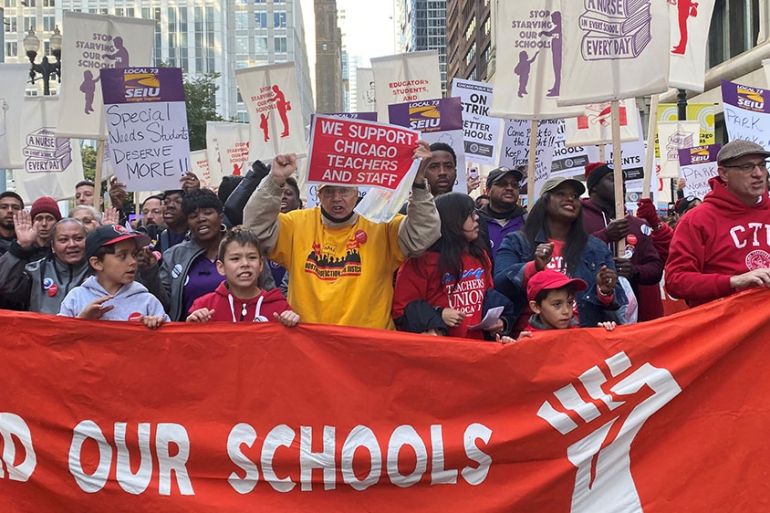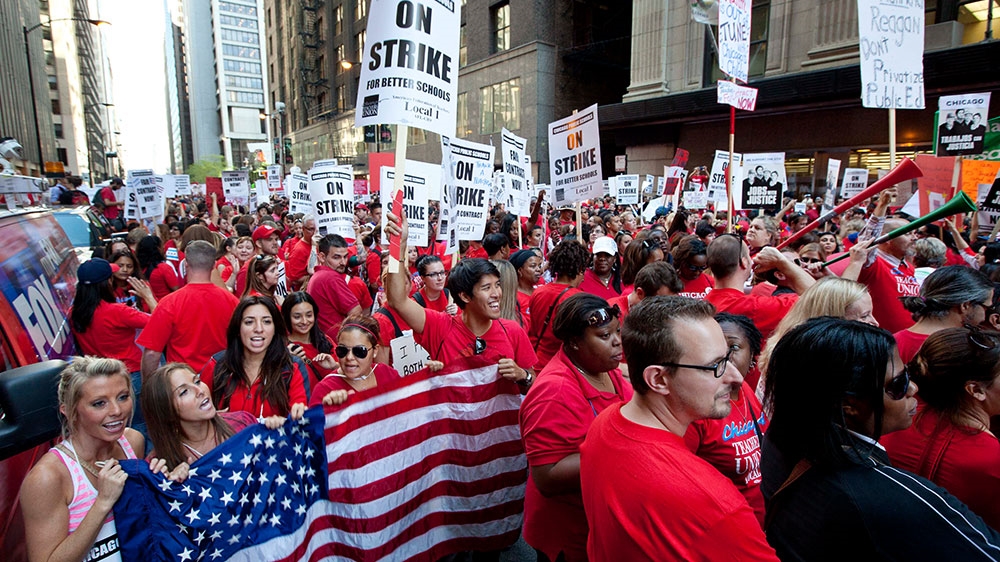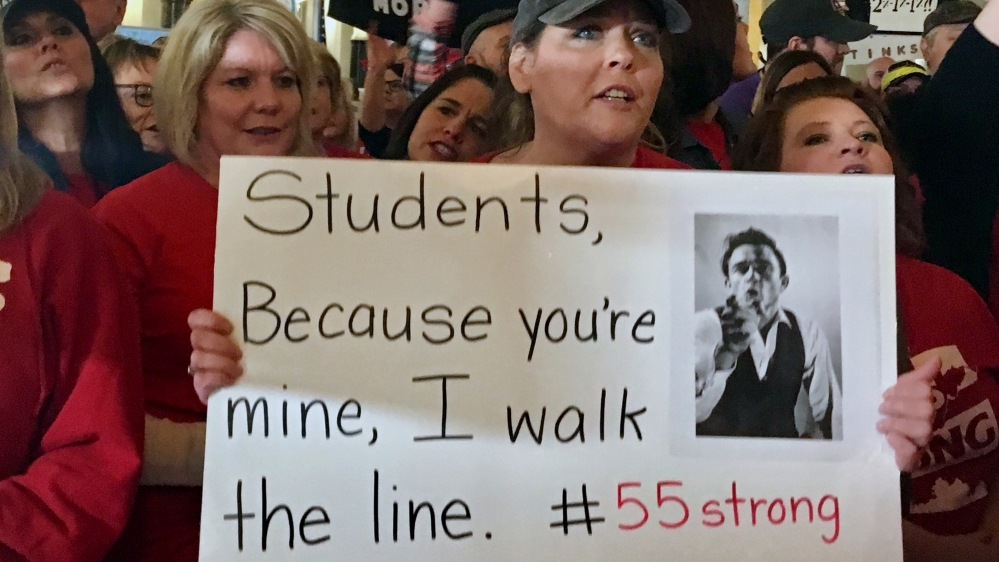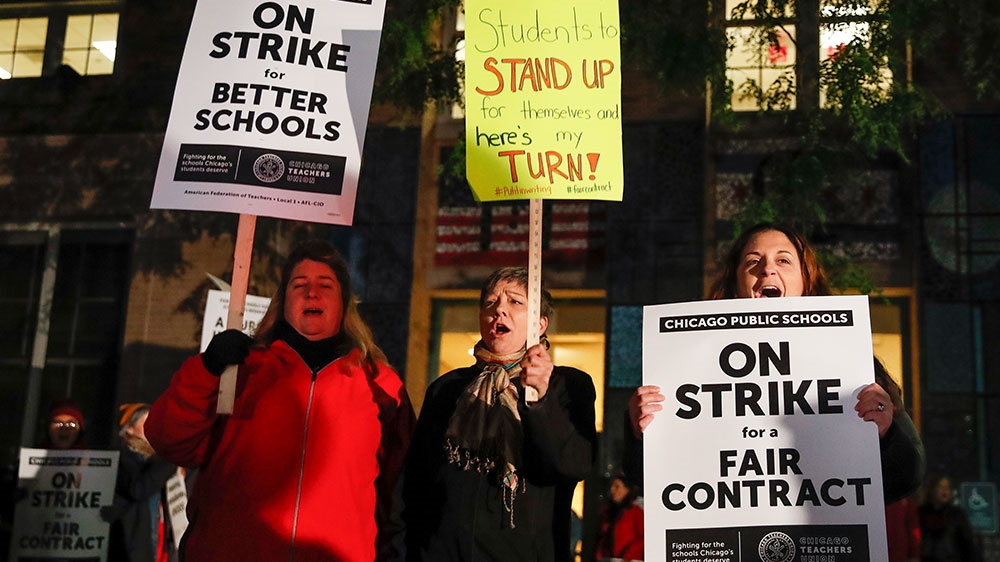US: A history of Chicago teacher strikes
Teachers in the US’s third-largest school district have gone on strike nine times since forming union in 1937.

Chicago, Illinois – This month’s teacher strike in Chicago, Illinois, wasn’t the first time that a Chicago Public School psychologist, Matt Clam had participated in a work stoppage in the district.
But Clam, the only school psychologist serving 3,100 students, said the demands are often the same: CPS needs more resources.
Keep reading
list of 3 itemsStriking Chicago teachers march through morning rush hour traffic
Chicago teachers’ strike: Thousands hit the picket lines over pay
“I hate that we’re picketing again, because I honestly we were past it,” Clam told Al Jazeera earlier this month. “I thought the funding formula was fixed and Rahm [Emanuel, Chicago’s last mayor] was gone and we had a newly elected progressive mayor [Lori Lightfoot] that campaigned on these same issues. Yet, here we are.”
Chicago teachers have gone on strike nine times since the Chicago Teachers Union (CTU) was formed in 1937, not including a 2015 standoff in which the city and the Chicago Teachers Union (CTU) struck a deal to keep working minutes before a deadline to strike would come into effect.

Under Illinois law, employers are not required to negotiate with unions over matters such as budget, organisational structure, hiring practices or standards of services. But union members are required to bargain over issues including pay, hours and employment conditions, which means that even if teachers turn their focus towards gaining resources such as mental healthcare for students, they must also include pay rises in their list of demands.
As Chicago teachers reach a deal, ending this month’s strike, Al Jazeera examines the history of educator strikes in the US’s third-largest school district.
1937-2012: Forming the CTU, first teacher strike
Educators officially created the Chicago Teachers Union (CTU) in 1937, bringing together several union groups that had been scattered across the city. It took nearly 30 years for the CTU to gain collective bargaining rights, and in 1966, they succeeded, winning the ability to negotiate for pay and resources on behalf of all members of the union. In 1968, a group of African American teachers led “a wildcat strike” – a strike without the union’s full approval – to protest racist hiring practices, linking teachers strikes with the Civil Rights Movement.
Teachers would strike seven more times before the 1987 strike, when the CTU went on its longest work stoppage – 19 days – on record. The 1987 strike centred on what the union had been demanding for decades – pay, smaller class sizes and resources for classrooms, issues educators remain familiar with today.
They were led at the time by Jacqueline B Vaughn, the CTU’s first female and first black president, who had been elected as the CTU’s recording secretary shortly after the wildcat strikes. She served as president from 1984-1994.
2012 strike changes the conversation
The CTU would not strike again until 2012.
Two years prior, a group of educators, support staff members, clinicians and parents won internal elections to take over CTU leadership. They were with the Caucus of Rank and File Educators (CORE) and led a campaign to replace long-entrenched union leaders.
CORE ran on social justice reform in Chicago Public Schools.
Two years later, CTU President and CORE member Karen Lewis announced teachers would go on strike. Their slogan was clear: The Schools Students Deserve.

The 2012 strike reframed education reform, not just in the city itself, but across the United States. Rather than focusing aggressively on pay rises, CTU turned their attention towards improving students’ lives.
The CTU demanded smaller class sizes, increased funding for music, art and physical education classes, paid teacher preparation time, increase in pay and a reduced emphasis on standardised testing results.
Then-Mayor Rahm Emanuel tried and failed to obtain a court order to force teachers back to their classrooms. After nine days, CTU members won a 16-percent pay rise over four years, an agreement for teachers who were to be laid off to be given priority when applying to other public schools and lower emphasis on standardised testing.
CTU helps lead the strike wave nationwide
Once teachers went back to work, the CTU began spreading their message across the country. Union leaders held town hall meetings with teachers in New York City, Pittsburgh, Cleveland, New Orleans, San Francisco, St Paul, Minneapolis, Tampa and Philadelphia. They emphasised a community approach to achieve educational reform, rather than working from the top down both within unions and when working with city and state officials.
Last year, teachers from West Virginia and Oklahoma went on strike, and teachers in Kentucky staged a “sickout”. As Chicago did in 2012, teachers focused on educational and social reform as well as fair pay. More than 485,000 workers went on strike in 2018, the highest figure since 1986, according to the US Department of Labor. More than 370,000 of those on strike were teachers protesting against declining pay, increasing class sizes and effects on students.

“We are one of the largest school districts in the nation,” said CPS teacher Kate, who has worked as a special education teacher for 14 years.
“Smaller schools in Oklahoma and West Virginia, and even our local school districts in the suburbs, used us as an example to strike,” Kate, who wished to withhold her last name, told Al Jazeera. “We’re a good example of camaraderie and unity. When you see 25,000 people walking in solidarity through downtown Chicago, that speaks volumes.”
2019: Striking for trauma care, classroom conditions
This year’s strike continued in that same vein, with teachers calling for not just a pay increase, but also better resources to improve the lives of children.
In a city where gun violence affects children and many undocumented families worry about deportation, educators have called an increase in the number of counsellors, nurses and social workers at public schools.
“My students need someone to be there for them when they need it,” Clam said.
“Not two periods later, or in some schools, two days later … My students need more mental health support from a counsellor or a clinician, but it can’t be just when they’ve already had a crisis or an emotional breakdown.”
Kate teaches 28 students, 11 of whom are in special education, in a hallway. She also has four children, two of whom are enrolled in CPS schools.
“All they did was give me some folding chairs and a whiteboard to go on the wall. We are out of space,” Kate said. “As a parent, I don’t want to see my kids in a class of 40 kids. You wouldn’t want to see your kids in that situation. Why are we fighting for this in the first place?”

She said her students face a number of challenges that make it difficult for her and other teachers to focus on academics.
“We have kids who have experienced sexual abuse, experienced gun violence, who have seen their parents die,” Kate said. “And we have one counsellor for 700 students.”
As teachers work in classrooms without heat in the winter, without air conditioning in the summer and attempting to handle the emotional trauma so many children face, Kate said, “It’s not so much about the paycheck.” Rather, the union remains focused on social justice and improving the lives of students.
“That’s what we’re fighting for – money towards resources, more clinicians, more people in the buildings,” she said. “If you knew about our class sizes and our resources, you would see it’s not about money at all.”
On Thursday, the city’s mayor announced CPS reached a deal with the CTU to end the October strike.
As part of the deal announced on Thursday, the two sides agreed on a five-year contract in which teachers be given a 16-percent pay rise over the life of the agreement. Teachers will receive a three-percent rise over the first three years of the contract and a 3.5-percent rise for the following two years.
The deal also includes funding for a social worker and nurse on site in every school and $35 million to help reduce class sizes.
The deal ended the 15-day strike, which kept students out of school for 11 days.